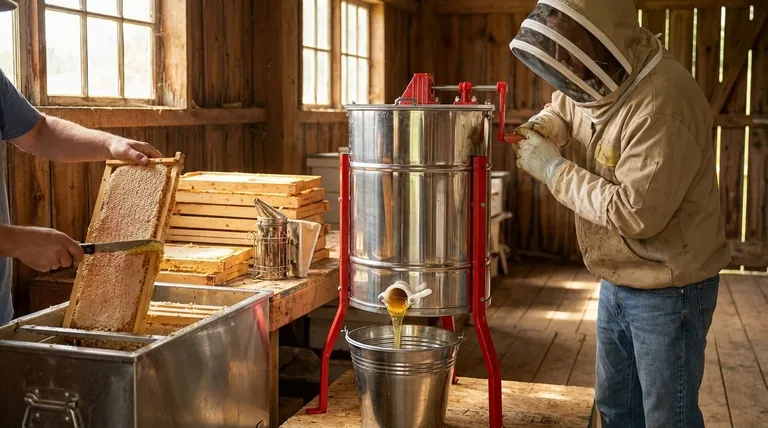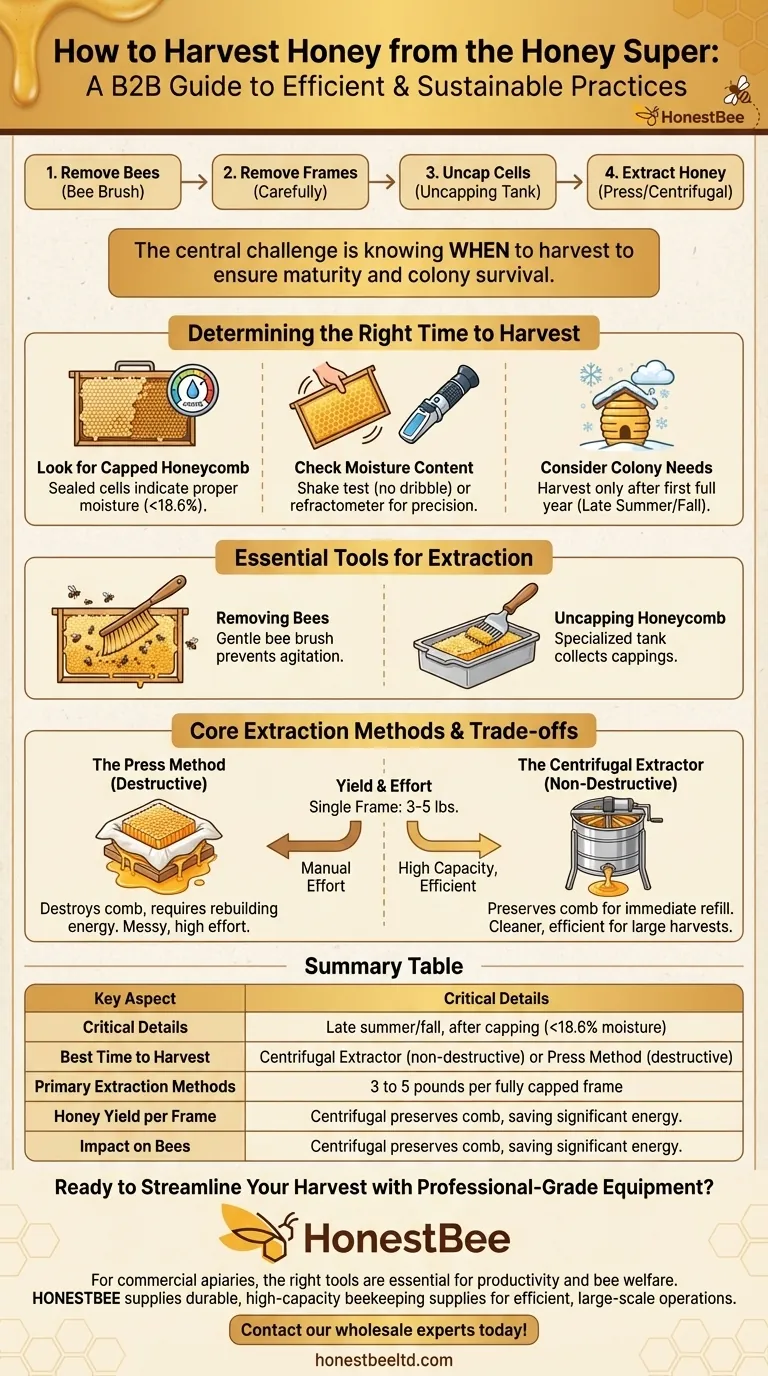At its core, harvesting honey from a honey super is a multi-step process that begins after the bees have done their work. Beekeepers first remove the bees from the frames, then carefully take the frames out of the hive. The protective wax cappings are then sliced off the honeycomb, and the raw honey is extracted from the cells, typically through pressing or centrifugal force.
The central challenge of harvesting honey is not the mechanical extraction itself, but knowing precisely when to harvest to ensure the honey is mature and the colony's survival is not compromised.

Determining the Right Time to Harvest
Timing is the most critical factor for a successful and sustainable honey harvest. Acting too early or too late can compromise the quality of the honey or the health of the hive.
Look for Capped Honeycomb
Bees signal that honey is ready by sealing the filled honeycomb cells with a fresh wax cap. This capping indicates the honey has been dehydrated to the proper moisture content (typically below 18.6%) and is stable for long-term storage.
Check the Moisture Content
For uncapped cells, beekeepers perform a simple shake test. If a frame is held horizontally and shaken, honey that dribbles out has too much water and needs more time in the hive. For precision, a device called a refractometer provides an exact measurement of the honey's moisture content.
Consider the Colony's Needs
A new beehive will almost never produce a surplus of honey in its first year. The colony needs its entire store to survive the first winter. Harvesting should only be considered after the first full year, typically in the late summer or early fall.
The Essential Tools for Extraction
Proper tools make the harvest process cleaner, more efficient, and less stressful for both the beekeeper and the bees.
Removing the Bees
A bee brush is the primary tool used to gently sweep bees off the frames before they are removed from the honey super. This ensures the bees are not harmed or agitated during the process.
Uncapping the Honeycomb
Once the frames are secured indoors, the wax caps must be removed. This is often done over an uncapping tank, a specialized basin that collects the wax cappings and allows any dripping honey to be saved.
Core Extraction Methods
Once the frames are uncapped, the honey must be removed from the comb. The chosen method depends on the beekeeper's scale, equipment, and philosophy.
The Press Method
This is a low-tech and straightforward approach. The honeycomb is cut from the frame, placed in a durable cloth (like calico), and then squeezed or twisted. The pressure forces the honey out through the cloth, after which it can be strained and bottled.
The Centrifugal Extractor Method
A more common and less destructive method involves a machine called a honey extractor. Frames are placed inside a drum that spins at high speed. Centrifugal force flings the honey out of the cells and onto the drum wall, where it slides down to a collection spout.
Understanding the Trade-offs
Each extraction method comes with significant consequences for the beekeeper and the bees. Choosing a method is not just a matter of convenience.
Destructive vs. Non-Destructive
The press method is destructive, as it completely destroys the honeycomb. The bees must then expend significant energy and resources to rebuild the comb from scratch before they can store honey again.
In contrast, centrifugal extraction is non-destructive. It preserves the delicate wax comb, allowing the beekeeper to return the empty frames to the hive. The bees can then immediately begin refilling the existing cells, saving valuable time and energy.
Yield and Effort
A single, fully capped super frame can yield between 3 to 5 pounds of honey. The press method is often described as messy and sticky, requiring significant manual effort. An extractor is a cleaner and more efficient process, especially for larger harvests.
Making the Right Choice for Your Goal
Your approach to harvesting should align directly with your beekeeping objectives and available resources.
- If your primary focus is a small-scale, low-equipment harvest: The press method is a viable option that requires no specialized machinery.
- If your primary focus is hive productivity and bee health: Centrifugal extraction is superior, as it preserves the comb and reduces the workload for the colony.
Ultimately, a successful harvest respects the immense work of the bees while efficiently securing the surplus they provide.
Summary Table:
| Key Aspect | Critical Details |
|---|---|
| Best Time to Harvest | Late summer/fall, after bees cap honeycomb (moisture <18.6%). |
| Primary Extraction Methods | Centrifugal Extractor (non-destructive) or Press Method (destructive). |
| Honey Yield per Frame | 3 to 5 pounds of honey from a fully capped frame. |
| Impact on Bees | Centrifugal method preserves comb, saving bees significant energy. |
Ready to streamline your honey harvest with professional-grade equipment?
For commercial apiaries and distributors, the right tools are not a luxury—they are essential for productivity and bee welfare. HONESTBEE supplies the durable, high-capacity beekeeping supplies and equipment you need for efficient, large-scale operations.
Contact our wholesale experts today to discuss how our extractors, uncapping tanks, and other professional gear can enhance your harvest yield and protect your valuable colonies.
Visual Guide

Related Products
- 2 Frame Stainless Steel Manual Honey Spinner Extractor for Beekeeping
- 6 Frame Manual Stainless Steel Honey Extractor Beekeeping Equipment
- HONESTBEE 72 Frame Industrial Electric Honey Extractor for Beekeeping
- electric honey extractor honey centrifuge 3 frame honey extractor stainless steel honey frame extractor
- Plastic Hand Crank 2 Frame Honey Extractor Low Price
People Also Ask
- What are the consequences of leaving honey in an extractor? Protect Your Honey Quality and Equipment
- What are some tips for using a honey extractor effectively? Maximize Your Honey Yield and Protect Your Comb
- How can a pressure washer be used to clean a honey extractor? A Guide to Safe and Efficient Cleaning
- What are the advantages of tangential honey extractors? Gentle, Affordable Honey Extraction for Your Apiary
- Can a manual extractor be upgraded to an electric one? Save Labor & Boost Efficiency



















